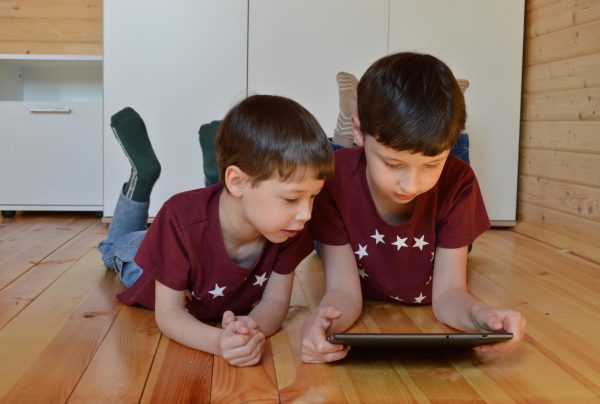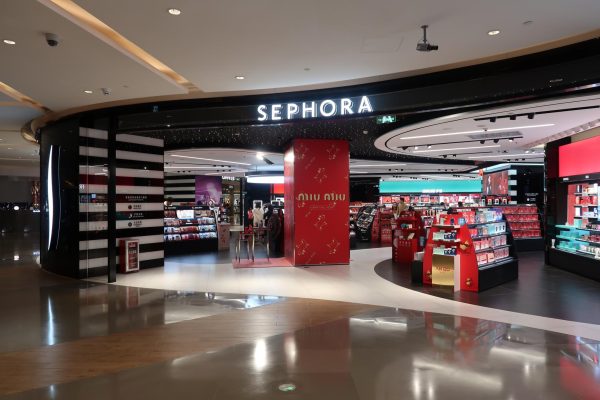With toothless smiles and sticky hands, kids have always seemed to reside in a world of their own, blissfully oblivious to everything around them. Even as people move into adulthood, the magic of childhood is something everyone finds themselves wishing to experience again on one occasion or another.
Yet with the rise of the internet, it seems as if some of this childhood wonder has been snuffed out. Petulant toddlers are now being soothed with iPads, and elementary age children are creating social media accounts on Instagram and TikTok.
While psychologists have always warned of social media sparking insecurity in teenagers, noting how it has been linked to rising rates of depression and anxiety, the subject of its use in elementary and middle school age kids has been a more overlooked subject. Recent studies suggest kids’ use of screens and social media is almost as bad as teenagers, averaging at four to six hours a day. As this new generation is only now emerging, everyone is watching the internet’s effects unfold for the first time.

The one effect almost everyone can agree on is that this new generation is maturing at an extremely rapid rate. In simpler terms, kids have traded legos for lip gloss.
Middle school has long been considered an “awkward stage” in one’s life, filled with braces and odd growth spurts. But all this is a thing of the past. Kids now have access to view social media accounts run by adults or older teenagers, many of whom are perpetuating unachievable beauty standards.
Furthermore, many of these accounts encourage “glow ups,” a trend that is causing children to seem older than they are. The idea of a “glow up” centers around growing up and becoming more attractive. Many influencers re-enforce this idea by showing pictures of them as kids versus them now. These younger pictures of them are usually middle school age, carrying across the narrative of awkward middle schoolers. These same influencers sharing their beauty evolution are also providing tips in order for others to follow suit.
While the intent behind these actions may be innocent, as younger children begin to come across these videos it creates a situation in which children are eager to appear older than they are, and racing to reach a beauty that is, for the most part, unattainable. This has created an unrealistic expectation that kids think they can fulfill with adult looks and products.
Recently, people have begun to notice how children have “infiltrated” stores usually targeted for older audiences. Most famously, kids have begun to flood Sephora, buying various skincare and makeup made for adults. Viral videos of seven year olds with vanities, packed with seventy dollar creams and powders, have flooded the internet. While the occasional blush or lip balm has always been the norm, even for younger people, children now have entire collections of beauty products that usually take years to build up.

Furthermore, anti-aging products have begun to find a new market: young children. As the majority of influencers on social media are adults, they also tend to market the latest anti-wrinkle cream or serum. Kids watching these videos begin to think they need these same products, creating a generation that is simultaneously obsessed with growing up and terrified of aging.
This is especially bad because many anti-aging products, like retinols, can be extremely harsh, especially on young skin, causing issues like Retinoid Dermatitis, a type of rash. Furthermore, retinols and other anti-aging products also cause skin to thin out, making it more susceptible to UV rays. Using these products at such a young age, especially while one’s body is still developing, can rapidly increase the rate of these issues coming into effect.
Even worse, companies are feeding into this premature aging, profiting off of their new audience, so much so that there has become a term for it: “Kids Getting Older Younger,” or KGOY for short.
Emerging in the early 2000s, more and more companies have begun to adopt this marketing theory. As children’s presence on social media grows, so does their exposure to various forms of advertising. Many corporations have begun to exploit this, choosing to direct their marketing towards impressionable children rather than adults, even when the products aren’t truly meant for younger audiences.
For example, the beauty company Drunk Elephant packages their skin care products in bright neon colors, making them more attractive to younger children. However, many dermatologists have found issues with this, explaining that many of their products are too harsh for young skin, especially since they contain things like retinoids in many of their products.
While many people have tried to bring it up with the company, the management refrains from doing anything about it, worried more about the money than the long term damage to children’s skin.
Furthermore, stores marketed to children have begun to disappear, leaving only stores targeted towards older audiences.
Even just ten years ago, shops like Justice marketed for a younger pre-teen audience were all the rage. Tops with sparkles and smiling animals filled the shelves and racks, and kids couldn’t wait to get their hands on the new designs. The same went for the latest glitter eyeshadow palette or lip balm flavor at Claire’s.
And as these stores continue to dwindle, kids have begun going to more adult and teen stores like Lululemon and Urban Outfitters, further facilitating the idea of grown up children.
The most worrying part of all this, however, is the direct criticism kids are receiving from adults on social media. The same influencers that children look up to for makeup and style advice have also become the first ones to make fun of them for acting older. Recently, it has become a trend online to call kids “bratty” and shame them for going to stores like Sephora and Lululemon.
Everyone knows the saying “don’t meet your heroes” and the same goes for influencers and their young fans. As children begin to realize the people they have based their entire life and appearance on are publicly criticizing them, it destroys their self esteem.
As children become the laughing stock of the internet, they continue to shy away from their childhood, then adults continue to make fun of them for this, creating a cycle in which young children constantly feel they are not enough.
Although this is clearly an issue, many influencers still fail to realize the impact their words have. While they can’t control who is watching their videos, they have good ideas on the demographics of their fans and followers.
Many influencers knowingly profit off of their younger audiences while also ridiculing them, creating a relationship that’s effects are still unfolding. While children’s seemingly ‘increase’ in maturity cannot be pinned alone on just influencers, it is important to address the faults that lie within them.
If social media continues to get into the hands of kids aged younger and younger, it will only continue to foster a culture in which children feel the need to act older, destroying the wonder our youth should hold.
We can’t completely stop social media from getting into young hands, but it is important both creators and companies alike begin to take into consideration the effects their actions have on younger audiences. Youth population can only increase and it is up to us to provide a brighter childhood for them.
Kids watching these videos begin to think they need these same products, creating a generation that is simultaneously obsessed with growing up and terrified of aging.

